 Iran’s Attack on Israel
Iran’s Attack on Israel
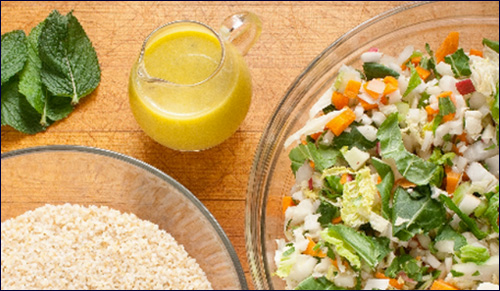

4 min read
3 min read
11 min read
16 min read
Maximize flavor with these easy to prepare and even easier to use dressings.
Excerpted from Remaining Kosher Volume One: A Cookbook for All with a Hechsher in Their Heart
Why craft your own vinaigrettes?
These flavor packed wallops are not just for lettuce and vegetables. They can be drizzled over a freshly cooked or cold piece of fish or meat. So, why not see them as a bridge over to a new way of lighter eating? I want you to think of them as homemade healthy convenient sauces.
All vinaigrettes are easy to prepare and even easier to use. You get a lot of bang for so little effort. Making vinaigrettes can be incorporated into your cooking routine. They will not only lighten up your family food. Simply put each one below maximizes flavor. Vinaigrettes do that handily.
Greens and fish need a lighter dressing than meat or cooked vegetables. Fruits are enjoyed tossed in a dressing using citrus fruit. It makes fruit sparkle.
Vinaigrettes have a long history of allowing salad greens, vegetables, fish and meats a way to be seen and heard. The French have given us a few choice working formulas for making dressings often using vinegars, lemon juice and white wine.
Vinaigrettes can also be plied with flavors that perhaps you never thought about. I have added a few of my own.
Below I list a few vinaigrettes that might prompt you into seeing the hidden promise that can be had on your plate and inside your bowls.
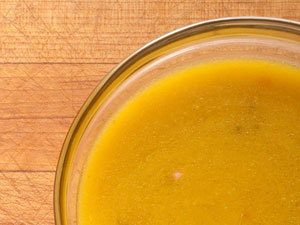
Salad dressings do sing songs. A well-dressed salad will possess a song line that enchants. Maybe salad dressings are the Cole Porter of food?
A refrain of mustard seeds keeps the tune happening inside your mouth.
Most of us buy dressing in bottles.
But a store-bought dressing becomes anything but a melody: it is only a refrain.
Dressing a salad is a deliberate activity. I take this activity for granted when the taste comes bottled.
What often gets blurred in this commercial transaction is that that the taste of the salad greens becomes vague.
This recipe reduces store bought orange juice to syrup- it becomes the vinegar if you will.
Then I add kosher Chinese mustard that is easily found on the grocer’s shelf.
Olive oil is left to smooth and add its sunny warmth.
“It’s delightful, it’s delicious, it’s de-loverly.”
Yield: 1½ cups
Special Equipment: whisk, bowl, kitchen towel
Pour the orange juice into a saucepan and boil. Reduce the orange juice to syrup, ending up with ½ cup.
Bring to room temperature.
Use a rubber spatula to scrape the “syrup” into a bowl that will also be used for the rest of the ingredients.
To toast the mustard seeds: place into a dry small skillet. Cover and cook over medium heat. Occasionally, gently shake the pan. Toast the seeds for about 1-2 minutes- they will begin to pop. The seeds will become fragrant and lightly browned. Don’t overcook!
Remove from heat. Put the mustard seeds on a plate to cool.
Chop the shallots into small dice and place into the bowl with the orange juice “syrup.”
Place a kitchen towel under the above bowl- this will help keep the bowl in place during the next steps.
Add in sugar, sesame oil, Chinese hot mustard, kosher salt, pepper, the room temperature orange juice syrup.
Whisk until blended.
Add in the mustard seeds.
Add the olive oil in a slow stream, whisking with the other hand.
Season to taste. Refrigerate until ready to use.
Serve
Re-whisk prior to serving.
I use this dressing with the Endive, Pear and Avocado Salad with Dried Roses.

This is a pretty salad with an easy blueprint.
All but one (red onion) of the salad ingredients are tailored long and thin.
The slicing activity that is especially easy if using the mandoline. For extra safety, slip a pot holder over your slicing hand.
All the Belgian endive leaves need to be separated washed and checked. Make sure the washing water is cold. Since endive leaves bruise, don’t agitate roughly.
Use the mandoline to slice the pears, avocados, cucumber and red onions, then cut into sticks. I base everything on the length of the endive.
The pears here are best when crunchy but sweet. When available, I use Anjou pears.
Buy the celery with leaves: use the innermost stalks for the salad.
Roses are here as a fragrant, lyrical touch. I find them in the Middle Eastern grocers- the brand I use even has a good hechsher.
You need to find an avocado that is just on the verge of getting ripe.
Yield: 6 servings
Special Equipment: mandoline, potholder, bowls
Dressing: above recipe- Burnt Orange-Chinese Mustard Dressing Vinaigrette with Roasted Mustard Seeds
Slice off and discard the bottom root of the endive. The leaves will fall off.
Fill a bowl with cold water- ice cubes are fine. Put the endive into the iced water.
Lift the endive leaves out of the water and place carefully on a kitchen towel to drain.
Assemble the mandoline and attach a slicing blade. Use the safety holder or slip your working hand into a pot holder.
Slice the pears, cucumbers and avocado into ¼ inch slices.
Make small piles of each sliced item.
Next, cut each into ½” slices and place into a mixing bowl.
Slice the onion into rings. Put the rings in the mixing bowl.
Cut the celery on a diagonal into thin slices and place into the mixing bowl.
Stack the endive leaves into small piles. Cut into ½ inch lengths and place into the mixing bowl.
Don’t toss!
Cover the cut vegetables and fruit with a wrung out wet paper towel and refrigerate.
Burnt Orange-Chinese Mustard Dressing Vinaigrette (above recipe) or a classic vinaigrette.
Serve
A few minutes before serving, toss the salad ingredients with dressing. The ingredients should be coated, not swimming.
I like to serve this salad with Burnt Orange Chinese Mustard Dressing, or a classic vinaigrette.
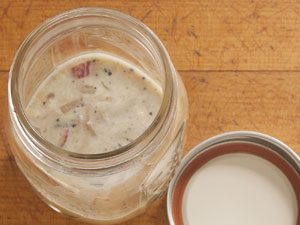
Think classic vinaigrette, for that is what this recipe truly is. However, you will be using clear chicken broth as an alternative to traditional oil.
I can’t claim it’s totally fat free, but it packs a lot of flavor. And it surely reduces fat. Yes, use it on your weekday salad greens if you are not going dairy.
Myself, I like this delicious dressing tossed in my chunky Mexican Roast Chicken Salad (the following recipe).
Ripened flavorful tomatoes, cucumbers, fresh seasonal dill and a good raw onion will benefit from this deliciously light dressing too!
This vinaigrette will give your leftover chicken broth a good home. I reduce two cups of chicken broth to a ¼ cup. The reduced stock mimics the juices left over in the roasting pan. Chicken essence, if you will. This will concentrate the dressing’s flavor and adds a muscular savory taste to whatever it is tossed with.
Its acidic partner is up to you. I use fresh lime juice. Freshly squeezed lemon juice is delicious as well.
This dressing needs refrigeration and may separate. To reconstitute, remove the metal lid and microwave the dressing for 10 seconds. Screw the lid back on and shake. The dressing should be used at room temperature, not warm or hot.
Yield: ¾ cup
Special Equipment: sauce pan, glass jar with screw lid
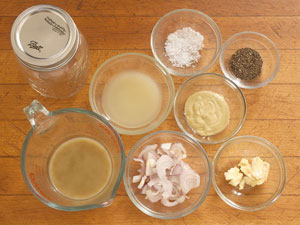
Pour the chicken stock into a saucepan and boil it down to a ¼ cup. Cool in the freezer.
Pour the lime juice (or lemon juice) into the jar. Add in the sliced shallots.
Use the back of a knife to smash the garlic clove and plop it in the jar. Add in the salt and pepper. Screw the lid on and shake for 10 seconds.
Add in the mustard. Pour in the cooled chicken stock. Screw the lid on and shake for 15-20 seconds.
Taste for salt and pepper. Refrigerate.
Serve
This dressing should be served at room temperature.
If refrigerated, take off the metal and cap off and microwave for 10-15 seconds. Stir.
Lightly toss your salad with the dressing. Add more as needed.
I like to use this vinaigrette on my Mexican Roast Chicken Salad.
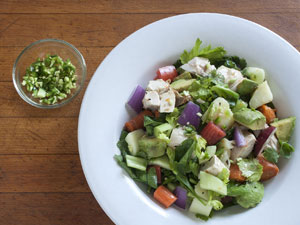
I am promoting the Chicken Broth Vinaigrette here and this chunky and generous chicken salad does that nicely. The vinaigrette is light and flavorful- you won’t miss the olive oil. The dressing will allow you to taste each vegetable and chicken without interruption. Yet, you will enjoy the double dose of chicken.
Roast the chicken yourself or pick up a pre-roasted at the kosher market.
The vegetables are all ones you know. The chicken gets cut into large chunks and so does everything else.
I always buy Pascal celery, the one with leaves. I hope you get into the habit, too. Celery leaves provide a burst of flavor in the mouth.
If it is fresh corn season, add some freshly cut niblets. Roasted pumpkins seeds would be a nice addition as well. Play with your food and make this salad your own.
Try to find a sweet onion: if it’s summer use red; use a Vidalia in its season; if it’s winter, use a white onion (as they are always mild).
This salad is even more delicious when the potatoes and carrots are still a little warm. Have all the other vegetables and chicken cut and ready, then toss into the bowl at the last minute.
This indulgent salad can feed many and feed them well. Just buy another chicken and double the vegetables.
And don’t forget the warm flour tortillas!
Yield: 4 – 6 servings
Special Equipment: vegetable peeler, small frying pan, sauce pan
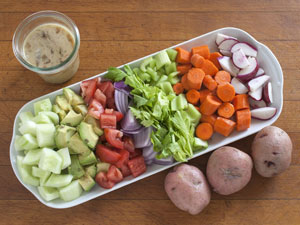
Get out a large bowl.
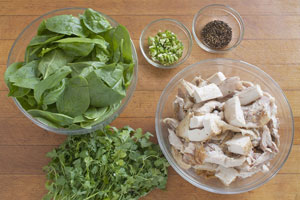
Pull and discard the bones from the roasted chicken. Discard skin if you want to keep the calories down. Cut the chicken into large chunks. Toss into the bowl.
In a dry frying pan, toast the cumin seeds over medium heat for about 1-2 minutes. Shake the pan occasionally. When the cumin seeds smell fragrant, shake them into the bowl.
Boil the potatoes in their jackets until easily pierced with a knife. Drain and cool. Cut into chunks. Place into bowl.
Place carrots chunks into water to cover, boil for 8 minutes. Drain and toss into the bowl.
Put the cleaned and checked celery leaves into the bowl.
Peel the celery stalks and cut into chunks. Toss into the bowl.
Cut the onion in half and place it face down on the cutting board. Cut each half again. Slice each quarter into fat slices. Toss into the bowl.
Cut the tomato in half and seed using a spoon. Cut into large chunks. Toss into the bowl.
Cut the washed radishes in half, then cut each half into fat wedges.
Cut the cucumber in half lengthwise. Use a spoon or melon baller to seed the cucumber. Cut into chunks. Toss in the bowl.
Cut the avocado lengthwise in half and remove the pit. Use a teaspoon to dislodge each half of avocado, then cut into large dice. Toss into the bowl.
Add in the washed/drained/checked spinach leaves and cilantro.
Finishing
Use your hands to gently toss all the ingredients together in your salad bowl.
Serve
If refrigerated, warm the Chicken Broth Vinaigrette to room temperature.
If you have just cooked the carrots and the potatoes, add to the salad bowl.
Right before serving, pour in all the dressing and gently toss the salad. Taste for seasonings.
Fold the tortillas in a damp, clean kitchen towel. Microwave for 10-15 seconds.
Put the chopped fresh chili on the table near those who know.

This dressing gets made in a standing blender. The preserved lemons will lose their mass. The dressing essentially amounts to their liquefied lemon remains.
We all like a dressing that coats: the question is “should it be a fur coat or a slicker?” Do we want our salads to be heavily covered or lightly shelled?
We all know what a ranch dressing features- it lays down a heavy blanket of creamy garlic enriched buttermilk. Ranch comes out of the refrigerator only when dairy salad is being served.
Thousand Island dressings are mayonnaise-based. Its work gets done by clinging to each ingredient and getting your salad to taste like a bowl of dip.
My preserved lemon dressing provides just enough cling to insure that the contents are dressed appropriately, no matter what the dressing has to deal with. This recipe is truly an all-purpose dressing.
Preserving lemons comes out of the Middle East, where this fruit has been cultivated for thousands of years.
Preserved lemons are just pickled lemons in salt brine. If you can make a carrot stick, you can make a pickle.
Perhaps the kosher market near you makes its own preserved lemons? Many do.
There is a real dialogue when this dressing is tossed into a salad, or warm bulgur, or roasted beets, or roasted potatoes.
Just a spoonful atop plainly prepared, fish, meat or chicken will accomplish the business of a delicious sauce.
No tyranny here. All the above foods (and more) still maintain their individuality when this dressing comes to call.
Yield: 1 cup dressing
Special Equipment: standing blender
Drop in the preserved lemon rinds, lemon juice, garlic, salt and pepper into the blender.
Blend to combine, making a rough paste.
With the motor running, add the oil in a slow, steady stream until fully liquefied. Finally add in the sumac.
Keep this dressing refrigerated for up to five days: just shake before use.
I use this dressing for the Chopped Salad with Bulgur.
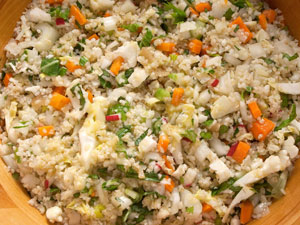
A salad you could lean on. Don’t think healthy, although it is. Think justified, because it all makes sense.
While I certainly encourage a visit to the produce aisle, whatever you have in your vegetable drawer can be chopped and easily given a new identity.
Bulgur is here to fuse the whole salad together.
The best part is that the finished salad sits in the refrigerator awaiting your spoon: it will beckon.
Once again, I call upon Preserved Lemons.
The bulgur and any of your chosen chopped vegetables are hurled ahead by the physical force of the dressing.
My refrigerator always seems to have a steady supply of chopped vegetable candidates. On occasion, I have been known to add in cooked eggplant.
An ardent list of vegetables, nuts, beans, dried fruit, herbs and cheese follows:
beans: lentils, fava beans, lima beans, black-eye peas, chickpeas
roasted nuts: pistachios, almonds, sunflower, pumpkin, walnuts, pecans, macadamia
cheese: feta
vegetables: bok choy, Chinese cabbage, carrots, celery stalks (and its leaves), white onions, green onions, red onions, Vidalia onions, kohlrabi, turnips, radishes, rutabagas, all colors of cauliflower, green onions, broccoli, corn, romaine lettuce, red cabbage, white cabbage, asparagus, zucchini, kale, Italian kale, fennel, yellow squash, green beans, sunflower sprouts
cooked: eggplant, pumpkin, onions, mushrooms
fruit: dried apricots dried cranberries, dried figs dates, yellow raisins, dried cranberries dried cherries
herbs: fresh/dried mint, basil, dill, fresh lavender
Add tomatoes or cucumber just before serving each portion: they mush and may ruin the entire batch.
Note:
The recipe easily doubles, triples, etc. to meet your needs: the formula for salad is three parts vegetables to one part bulgur.
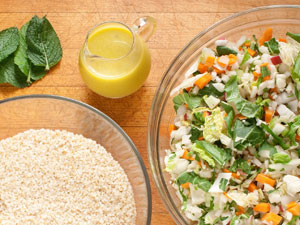
Salad Ingredients
all vegetables/herbs: wash and check
Yield: 6 servings plus leftovers
Special Equipment: two large bowls, standing blender
Place the uncooked bulgur in a large mixing bowl. Cover with boiling water.
Cover the bowl tightly with plastic wrap. Let the bulgur sit undisturbed for 20 minutes to absorb the water.
Uncover and add in 3½ cups chopped vegetables, dried fruit, herbs, or cheese.
Stir in ½ cup Preserved Lemon Dressing. More if you want!
Stir by bringing the bulgur to the top while slowly rotating the bowl, thereby combining all the ingredients. Taste for seasoning. Freshly ground black pepper really sings here.
Serve
Remember to add tomatoes or cucumber just before serving each portion: otherwise, they mush and may ruin the entire batch.
Spoon salad into individual bowls: or place on the table and let diners serve themselves.
Leftovers are good to dip into for at least three days.
Click here to see the eBook at Apple. Or visit: LaurenStacyBerdy.com.
